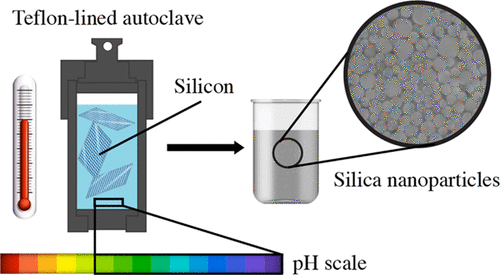当前位置:
X-MOL 学术
›
ACS Sustain. Chem. Eng.
›
论文详情
Our official English website, www.x-mol.net, welcomes your
feedback! (Note: you will need to create a separate account there.)
Environmentally Friendly Method of Silicon Recycling: Synthesis of Silica Nanoparticles in an Aqueous Solution
ACS Sustainable Chemistry & Engineering ( IF 7.1 ) Pub Date : 2020-08-28 , DOI: 10.1021/acssuschemeng.0c03783 Julia V. Bondareva 1 , Timur F. Aslyamov 1 , Alexander G. Kvashnin 2 , Pavel V. Dyakonov 1 , Yulia O. Kuzminova 1 , Yuri A. Mankelevich 3 , Ekaterina N. Voronina 3, 4 , Sarkis A. Dagesyan 4 , Alexander V. Egorov 5 , Roman A. Khmelnitsky 6 , Michael A. Tarkhov 7 , Nikolay V. Suetin 3 , Iskander S. Akhatov 1 , Stanislav A. Evlashin 1
ACS Sustainable Chemistry & Engineering ( IF 7.1 ) Pub Date : 2020-08-28 , DOI: 10.1021/acssuschemeng.0c03783 Julia V. Bondareva 1 , Timur F. Aslyamov 1 , Alexander G. Kvashnin 2 , Pavel V. Dyakonov 1 , Yulia O. Kuzminova 1 , Yuri A. Mankelevich 3 , Ekaterina N. Voronina 3, 4 , Sarkis A. Dagesyan 4 , Alexander V. Egorov 5 , Roman A. Khmelnitsky 6 , Michael A. Tarkhov 7 , Nikolay V. Suetin 3 , Iskander S. Akhatov 1 , Stanislav A. Evlashin 1
Affiliation

|
In future decades, tons of silicon waste will be produced from various sources, with no reliable recycling route. The transformation of bulk silicon into SiO2 nanoparticles is significant because it provides an environmentally friendly way to recycle residual silicon waste. To address the needs of silicon recycling, we have developed a top-down approach that achieves 100% conversion of bulk silicon to silica nanoparticles with outcome sizes of 8–50 nm. In contrast to our approach, previous studies on the preparation of silica nanoparticles were based on the bottom-up method, where alkoxides served as the silicon source. In addition to silicon processing and upcycling the potential of silica, our method also possesses several advantages, such as simplicity, scalability, and controllable particle size distribution. Many fields of science and manufacturing, such as optics, photonics, medical, and mechanical applications, require size-controllable fabrication of silica nanoparticles. We demonstrate that control over temperature and hydrolysis time has a significant impact on the average particle size and distribution shape. Additionally, we unravel the process of nanoparticle formation using a theoretical nucleation model and quantum density functional theory calculations. Our results provide a theoretical and experimental basis for silica nanoparticle fabrication and pave the way for further silicon conservation research.
中文翻译:

环保的硅回收方法:水溶液中二氧化硅纳米颗粒的合成
在未来的几十年中,将通过各种来源产生大量的硅废料,而没有可靠的回收途径。块状硅向SiO 2的转化纳米颗粒非常重要,因为它提供了一种环保的方式来回收残留的硅废料。为了满足硅回收的需求,我们开发了一种自上而下的方法,可实现将块状硅100%转化为二氧化硅纳米颗粒,结果尺寸为8–50 nm。与我们的方法相反,以前对二氧化硅纳米粒子制备的研究基于自下而上的方法,其中醇盐用作硅源。除了硅加工和二氧化硅的潜力升级外,我们的方法还具有一些优点,例如简单,可扩展性和可控的粒度分布。科学和制造的许多领域,例如光学,光子学,医学和机械应用,都需要尺寸可控制的二氧化硅纳米颗粒的制造。我们证明了控制温度和水解时间对平均粒径和分布形状有重大影响。此外,我们使用理论成核模型和量子密度泛函理论计算来阐明纳米颗粒的形成过程。我们的结果为二氧化硅纳米颗粒的制备提供了理论和实验基础,并为进一步的硅保护研究铺平了道路。
更新日期:2020-09-21
中文翻译:

环保的硅回收方法:水溶液中二氧化硅纳米颗粒的合成
在未来的几十年中,将通过各种来源产生大量的硅废料,而没有可靠的回收途径。块状硅向SiO 2的转化纳米颗粒非常重要,因为它提供了一种环保的方式来回收残留的硅废料。为了满足硅回收的需求,我们开发了一种自上而下的方法,可实现将块状硅100%转化为二氧化硅纳米颗粒,结果尺寸为8–50 nm。与我们的方法相反,以前对二氧化硅纳米粒子制备的研究基于自下而上的方法,其中醇盐用作硅源。除了硅加工和二氧化硅的潜力升级外,我们的方法还具有一些优点,例如简单,可扩展性和可控的粒度分布。科学和制造的许多领域,例如光学,光子学,医学和机械应用,都需要尺寸可控制的二氧化硅纳米颗粒的制造。我们证明了控制温度和水解时间对平均粒径和分布形状有重大影响。此外,我们使用理论成核模型和量子密度泛函理论计算来阐明纳米颗粒的形成过程。我们的结果为二氧化硅纳米颗粒的制备提供了理论和实验基础,并为进一步的硅保护研究铺平了道路。











































 京公网安备 11010802027423号
京公网安备 11010802027423号